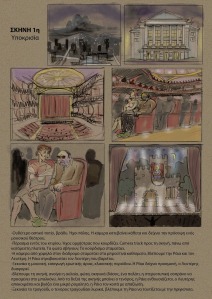http://www.surveillance-and-society.org/journalv1i3.htm
Deriving from Foucault’s work, space is understood to be crucial in explaining social power relations.
However, not only is space crucial to the exercise of power but power also creates a particular kind of
space. Through surveillance cameras the panoptic technology of power is electronically extended. The
article examines parallelisms and differences with the Panopticon and contemporary cities: visibility,
unverifiability, contextual control, absence of force and internalisation of control. Surveillance is examined as an emotional event, which is often ambivalent or mutable, without sound dynamic of security and
insecurity nor power and resistance. Control seems to become dispersed and the ethos of mechanistic
discipline replaced by flexible power structures. Surveillance becomes more subtle and intense, fusing
material urban space and cyberspace. This makes it impossible to understand the present forms of control
via analysing physical space. Rather, space is to be understood as fundamentally social, mutable, fluid and
unmappable – ‘like a sparkling water’. The meaning of documentary accumulation changes with the ‘digital
turn’ which enables social sorting. The popularity of ‘webcams’ demonstrate that there is also fascination in
being seen. The amount of the visual representations expands as they are been circulated globally.
Simultaneously the individuals increasingly ‘disappear’ in the ‘televisualisation’ of their lives. The
individual urban experience melts to the collective imagination of the urban. It is argued that CCTV is a
bias: surveillance systems are presented as ‘closed’ but, eventually, are quite the opposite. We are facing
‘the cam era’ – an era of endless representations.
The major effect of the Panopticon is, in Foucault’s words (1977: 201), ‘to induce in the
inmate a state of conscious and permanent visibility that assures the automate functioning
of power’. The emphasised meaning of visibility is perhaps the most obvious and often
recognised panoptic principle. The basic nature of the exercise of disciplinary power
‘involves regulation through visibility’ (Hannah, 1997a: 171). ‘Power is exercised
through ‘the “eye of power” in the disciplinary gaze’ (Ramazanoglu, 1993: 22). To be
able to see offers the basic condition for collecting knowledge, for being ‘in control’. In
urban space ‘absolute visibility is legitimated with the claim and the guarantee of
absolute security’ (Weibel, 2002: 207). Both in the Panopticon and in the space of
surveillance, social contact is – most often – reduced to visual (Koskela, 2002). It is,
however, worth noting that many surveillance systems include loudspeakers which can
mediate messages to the public – as per the idea of ‘a speaking tube system’ in the
Panopticon (Ainley, 1998: 88
‘Cam Era’ – the contemporary urban
Panopticon.*
Hille Koskela1
Koskela: ‘Cam Era’
Surveillance & Society 1(3) 297
He writes about ‘space of our dreams’, ‘internal’ and ‘external’ space, and ‘a space that
can be flowing like a sparkling water’. Foucault glorifies space – by talking about ‘the
epoch of space’ (1986: 22) which is replacing the important role of time (i.e. history) –
but simultaneously builds concepts that are disengaged from architecture and come close
to the idea of the social production of space. Rather than politics and economy (which
have quite often been the basis for the argument that space is socially produced) he
describes the spaces created by human habits, cultures and religions. This means that
Foucault’s ideas come close to Lefebvre’s concept of ‘representational space’ (1991: 39)
which he describes as ‘space as directly lived through its associated images and symbols,
and hence the space of “inhabitants” and “users” […] space which the imagination seeks
to change and appropriate’. Unfortunately, this work was never published by Foucault
himself and the concepts used were never developed further.
In analysing the parallelisms and differences with the Panopticon and contemporary
cities, it is important to acknowledge that urban space is far more complex than the
concept of space in Foucault’s interpretations of the prison. In cities, people may
sometimes be metaphorically imprisoned but, nevertheless, they are not under isolation
but quite the opposite: a city is a space of endless encounters. Whereas a prison is an
extremely homogenous space, a city is full of diversity. This diversity – of both spaces
and social practices – makes it impossible to compare urban space simply and directly to
the Panopticon. ‘Too much happens in the city for this to be true’, as Soja (1996: 235)
points out. However, there are several principles, characteristic to the mechanism of the
Panopticon, which are clearly present in the surveillance of cities. Some are almost selfevident
some more unexpected, but yet, they are all worth specifying.
‘A dream of a transparent society’
The major effect of the Panopticon is, in Foucault’s words (1977: 201), ‘to induce in the
inmate a state of conscious and permanent visibility that assures the automate functioning
of power’. The emphasised meaning of visibility is perhaps the most obvious and often
recognised panoptic principle. The basic nature of the exercise of disciplinary power
‘involves regulation through visibility’ (Hannah, 1997a: 171). ‘Power is exercised
through ‘the “eye of power” in the disciplinary gaze’ (Ramazanoglu, 1993: 22). To be
able to see offers the basic condition for collecting knowledge, for being ‘in control’. In
urban space ‘absolute visibility is legitimated with the claim and the guarantee of
absolute security’ (Weibel, 2002: 207). Both in the Panopticon and in the space of
surveillance, social contact is – most often – reduced to visual (Koskela, 2002). It is,
however, worth noting that many surveillance systems include loudspeakers which can
mediate messages to the public – as per the idea of ‘a speaking tube system’ in the
Panopticon (Ainley, 1998: 88).
The Panopticon embodies the power of the visual. Visibility connotates with power.
Within surveillance, visibility does not just have an important role but its meaning
overpowers other senses. This has consequences, as I shall argue, to how prejudice is
structured. By increasing surveillance ‘[a] dream of a transparent society’ (Foucault,
1980:152), a society where everything is subjugated to visual control, has almost been











 landscape and arch.
landscape and arch.
















